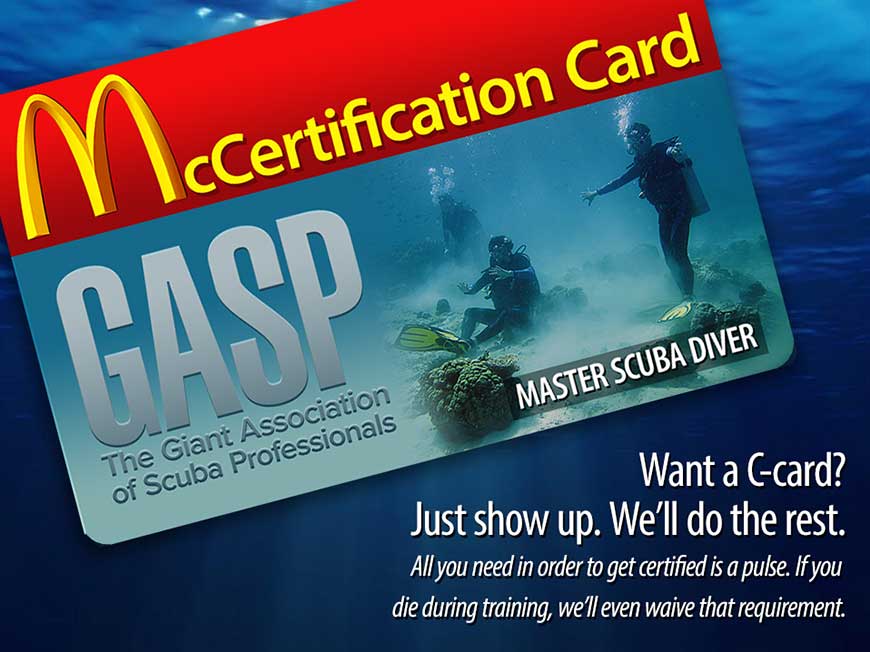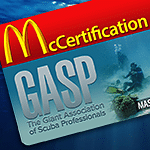Most of us are aware of a trend in public education in which students are not allowed to participate in competitions or games that have clear winners and losers, or in which everyone who participates doesn’t receive some sort of trophy or medal. The rationale is that it is better to leave students totally unprepared for the realities of life than it is to bruise anyone’s fragile ego. Well, guess what? We’ve apparently reached that point in diver training as well.
Watch the following video, then ask yourself, Would you certify this student?
Does it come as any surprise that this student was certified — without having to go back and correct his ineffective kick or demonstrate any real mastery of buoyancy control? We see this happen far too frequently. You most likely do, too.
How does this happen? I mean, clearly this student is a danger to himself and any potential buddies. Equally as bad, he can’t possibly be having any fun.
There is no single reason for this failure; however, there are two primary contributing factors. These are:
- The growing belief that the chief criteria for getting a certification card should be simply showing up. Just as with the Everyone gets a trophy mentality in public education, the norm now seems to be that, if you show up for both weekends of an Open Water Diver course, you are guaranteed a c-card.
- The checklist mentality — the belief that the sole criteria for certification should be whether or not students demonstrate “mastery” of all of the “skills” on a checklist. An overall assessment of their competence as a diver never enters into the equation.
Can you really certify someone in as little as two weekends?
Available evidence suggests that the most popular format for a modern Open Water Diver course is a weekend of classroom and confined-water training, followed by a weekend of open-water dives. Say what you will about how great it was when classes were longer, the fact is, few dive stores can be competitive unless they offer entry-level courses on such a compressed schedule.
At best, this allows for four to six hours of confined-water training, followed by one to two hours of open-water training. If this adequate?
For some students, it can be. But it cannot be adequate for all students. If you are consistently passing all — or nearly all — of the students who take part in such classes without anyone having to go back and repeat one or more confined-water sessions or open-water training dives, you are doing something wrong. You are depriving those students who most need your attention of the ability to fully develop critical abilities and, worse, you are putting their safety at risk.
You need to make it abundantly clear, both in your orientation sessions and in the learning agreement you have students sign, that simply attending all scheduled confined- and open-water training dives does not guarantee certification. Certification is awarded only when all of the necessary requirements are met and you are confident of the students’ ability to dive safely within the limits of their current level of certification.
So your students scheduled their course at the last minute before leaving on a Caribbean vacation? That’s too bad. If they can’t demonstrate adequate ability, they won’t be leaving with a c-card in their pockets. ‘Better to leave disappointed than to come home in a body bag.
It takes more than a checklist
It appears that, for the past several decades, most instructor candidates have been taught that the sole criteria for certification is whether or not students can demonstrate “mastery” of the two dozen or so skills that appear on their instructor cue cards and in the student record form. What most are apparently not being taught is how to make an subjective assessment of whether or not students can dive safely within the limits of certification.
Consider the student you saw earlier in the video. While this student was able to demonstrate adequate “mastery” of skills such as mask clearing and regulator recovery, nowhere on his instructor’s checklist was there an assessment of basic propulsion techniques or overall buoyancy control. More importantly, nowhere did the cue cards or training record ask the single most important question of all: Would I trust this person to dive with my loved ones?
Worse, many new instructors come away with the impression that, as long as students can muddle through all of the skills on the checklist, not only can an instructor certify them, he or she must certify them. That’s a formula for disaster.

Teaching to a higher standard
Make no mistake: If your training agency’s standards require that students demonstrate adequate performance of a particular skill, you must include that skill in your training. Understand, however, that this is a starting point, not an ending point. You need to go beyond this, and teach to a higher standard. Specifically:
- Make it clear to students at the onset that just because it is possible for some students to complete the requirements for certification within a compressed time frame, not every student can or will do this. Make certain students fully understand your policy for repeating confined- and open-water training dives, if needed.
- Don’t be afraid to assess students’ overall ability based on more than just the items on the checklist.
In particular:
- Make sure students can demonstrate all fundamental abilities, including adequate buoyancy control, body position and propulsion techniques — even if these items do not appear on a checklist or cue card.
- It’s not sufficient if students can merely muddle through the items on the checklist once, after repeated failed attempts. Students must be able to perform any skill on demand, repeatedly, without significant error and without undue stress. And they need to be able to perform all core skills while maintaining neutral buoyancy.
- Remember that, no matter how well students can demonstrate basic abilities, it doesn’t matter if they lack the knowledge, attitude and discipline needed to dive safely. Flunking a student for attitude is perfectly okay.
- Don’t forget to ask the single most important question of all. That is, Would I trust this person to dive with my loved ones? If in doubt, do not issue a c-card.
Just because diving has been taught in a particular fashion for the past 60 years doesn’t mean you have to settle for anything less than excellence. Change can happen. Let it start with you.

